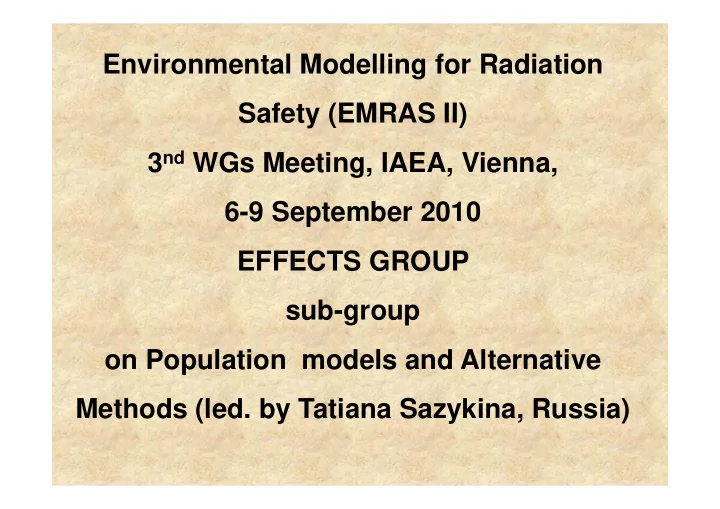

Environmental Modelling for Radiation Safety (EMRAS II) 3 nd WGs Meeting, IAEA, Vienna, 6-9 September 2010 EFFECTS GROUP sub-group on Population models and Alternative Methods (led. by Tatiana Sazykina, Russia)
Participants of the sub-group Population Models and Alternative Methods. Name Organisation, country Jordi Vives i BATLLE Westlakes (UK) Tom HINTON IRSN (France) Isao KAWAGUCHI NIRS (Japan) Alexander KRYSHEV SPA Typhoon (Russia) Angelica LORENTZON SKB (Sweden) Tatiana SAZYKINA SPA Typhoon (Russia) Karolina STARK Stockholm Univ. (Sweden) Satoshi YOSHIDA NIRS (Japan) Tamara YANKOVICH Ecometrix (Canada) Luigi Monte Italy Rodolfo AVILA * Sweden Jim SMITH* UK Frédéric ALONZO IRSN (France) Rodolphe GILBIN IRSN (France) Rudie HELING NRG (NL)
At the First EMRAS II meeting an activity timetable was developed for the years 2009-2011. TASKS Task Completion 3. Pop. Models and Alternative Methods 3a. review existing population models 3a: July 2009 (Yes) 3b. develop generic population model 3b: Jan. 2010 (in work) for radiological assessment 3c. develop scenario for model 3c:March 2010 (Started) application (e.g. exposure levels for 10% decrease in population) 3d. develop life history data sheets 3d: Oct. 2010 (Started) 3e. explore alternative methods 3e: Dec. 2010 3f. run models, compare results 3f: July 2011 3g. reports; publications 3g: Sept. 2011
Task 3a: Review of existing population models appropriate for adaptation in radiation effect assessment (non-human biota). Outcome: at least 8 population models, most of which were specially designed to describe radiation effects in populations, and some can be adapted to simulate radiation effects.
Task 3b. develop generic population model for radiological assessment The task was discussed at the meeting in January 2010. The goal was the developing simple models using a generic population approach, which will be able to simulate main features of radiation effects in a population, and show the key parameters, responsible for the resistance of population to radiation damage.
Outcomes from the task 3b: Some generic models were suggested: •Logistic growth model (all); •Population model with 2 stages – young and mature organisms (Jordi Vives, Luigi Monte, Frederic Alonzo); •Population model with stochastic parameters (risk of extinction) (Isao Kawaguchi); • Population in a limited environment with “dose rate- effect” formulas for model parameters (Sazykina, Kryshev)
The present task 3c: develop scenario for model application and model comparison We have two choices: • a benchmark scenario, assuming a set of generic populations with different life characteristics (for example, some of RAPS ) and calculate the populations changes in case of chronic radiation exposure; obtain population responses to exposure equal to 10% decrease in reproduction (or 10% in mortality). • a scenario with real population exposed to radiation (for example Daphnia population), and comparison of model results with real data. .
It seems, that a benchmark scenario is good as a first step for model comparison. What is the practical importance of the benchmark scenario: •Run the generic models for a range of different dose rates; obtain an output as a population response to exposure (“population dose rate-effect” curves/(formulas)); •Compare the results for different generic models;
•Compare the “dose rate-effect” curves for individual organisms and “population dose rate-effect” curves; •Select generic population models most appropriate for various ecological situations; •Make conclusions about the population radiosensitivity vs. organism’s radiosensitivity.
• What data are needed for running the benchmark scenario? •We need to complete the task 3d. “develop life history data sheets” and derive population characteristics for reference species; •Collect radiobiological data for reference species in form of “dose rate-effect” curves.
•At present, data on life characteristics of reference animals are collected, including the following: •Longevity; longevity of immature and mature states; •Growth rate (estimated from logistic or Gompertz’ models; •Basic metabolic rate; •Mortality rate (IMR and MRDT); •Adult weight, weight at birth; •Reproduction (number of newborns per year).
Sources of information are the following: •Internet database AnAge: The Animal Ageing, Longevity and Life history http://genomics.senescence.info/species •Database of fish growth characteristics: http://www.fishbase.org/Popdyn •Big database on mammalian basal metabolic rates is in the Supplement to the paper by White and Seymour (2003) Proc. Natl.Acad.Sci.USA 10.1073/pnas.0436428100 (available in the Internet)
•Useful monograpns on the subject: •“ Population parameters: estimation for ecological models ” (available in the Internet); • “Wildlife population growth rates” by Sibly R.M., Hone J, T.H.Clutton-Brock (available in the Internet); •“ Ecological Implications of Body size ” by Peters RH (1986) Cambridge
•Examples of life history data sheets for different species of animals are given in an attachment file. •Luigi Monte prepared a presentation on estimation of parameters of population models for calculating the radiation effects on population level. •Next step – predicting radiation effects for populations of different species, using generic population models. •Modellers are requested to give their contributions to population parameters database !
THANK YOU FOR YOUR ATTENTION!
Recommend
More recommend